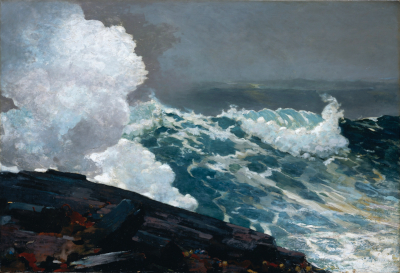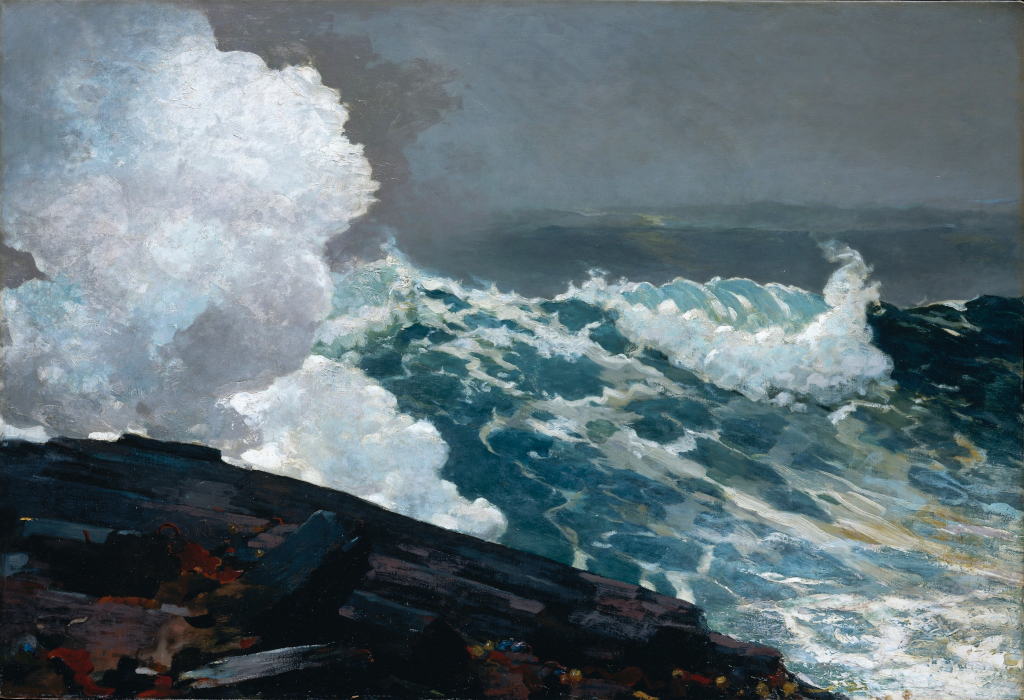 Buy Art Prints Now
Buy Art Prints Nowfrom Amazon
* As an Amazon Associate, and partner with Google Adsense and Ezoic, I earn from qualifying purchases.
Northeaster is an 1895 painting by Winslow Homer which can be found in the collection of the Metropolitan Museum of Art, New York City, US. He was a skilled marine artist, with this piece being one of many examples of his contribution to this genre.
The artist, within Northeaster, captures a wave crashing aggressively against a rocky shoreline. It was produced in the American region of Maine, and the artist would produce several of his most famous paintings here, including the likes of The Fog Warning and Breezing Up (A Fair Wind). Although Winslow Homer worked in a number of different genres within his career, it is perhaps his seascapes such as this that became his signature style. The artist loved this area of the US and eventually chose to live here, setting up a studio and taking advantage of the natural beauty to be found here. His tended to be drawn to active environments, in which the full power of nature was unleashed. Crashing waves would therefore appear several times, with Northeaster being one of the more memorable examples of that. This piece measures 128cm in width, and 87.6cm tall and did not need to be overly large because of the content placed on it. Traditionally, seascape painters who avoid just covering the sea by itself, and feel obliged to add humanity somewhere into the composition but Homer saw things differently and felt it acceptable to focus entirely on the natural environment around him. Several years later, the artist would also produce The Gulf Stream, which was another highlight from his career.
Northeaster does not refer to a location in the US, but actually is a name given to a specific type of cyclone that occurs within the western North Atlantic Ocean. Clearly, the title is used here to explain the dramatic waves crashing in the foreground. The artist allows a small section of rock to cut across the bottom left corner of this painting, whilst a stunning section of sea rides in from the back of the painting. The mood is set by the wave to the left which rises up into the sky, whilst the rest of the water arches up as if to signify another wave building to the right hand side. Winslow Homer is clearly placed on the shoreline whilst working, but close enough to the action to feel this drama deep in his soul. Of all the places that he had visited up to this point, it would be Maine that would take his heart and persuade him to move here. He would have been in his late fifties by this point, and so it made sense that he would not have wanted to travel the long distances that he did as a younger man. Having a studio within this region allowed quick, simple visits to the coastline in order to continue working without too much hassle.
There is an interesting history to this piece, as described by its current owners, the Metropolitan Museum of Art in New York. It turns out that actually the artwork initially did have figurative work upon it, but that later this was removed to produce the pure seascape that remains today. Incredibly, the painting had already been finished and sold, even exhibited. But at some point later on it was decided by Homer that he should re-work the piece and remove the fishmermen, who previously had been perched upon the rocks. This would change the meaning and balance of the piece, which left its mood of danger and fear, instead being more of a celebration of the power of nature. Northeasters are well known within this part of the US, making this an interesting addition to the permanent collection of the Met. This impressive institution also holds other Winslow Homer paintings, such as Prisoners from the Front, Eagle Head, Manchester, Massachusetts (High Tide) and also Camp Fire. It remains perhaps the best location from which to learn more about this specific artist.




